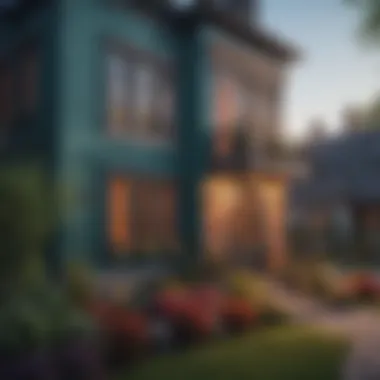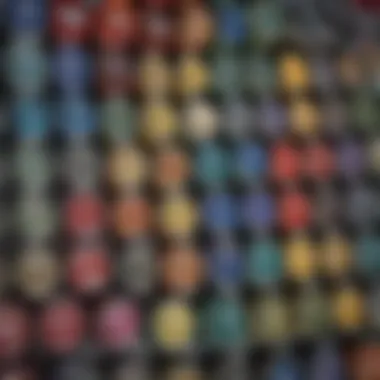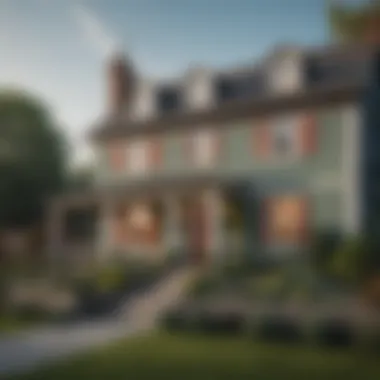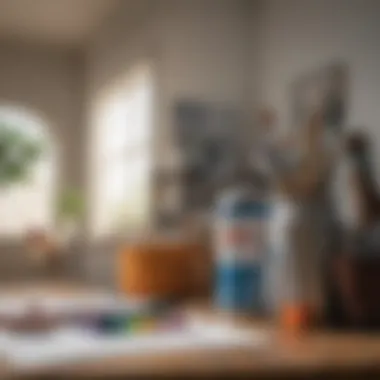Understanding the Cost per Square Foot to Paint Your Home


Intro
This section will explore key insights and trends influencing the costs associated with exterior painting projects. Factors such as regional price variations and the types of materials used will be examined. It is crucial to provide a comprehensive view of what can affect the final bill, especially for those interested in managing their budgets effectively.
Key Insights and Trends
The exterior of a house often serves as its first impression. Recent trends reveal homeowners are increasingly mindful of aesthetics, but they also weigh the long-term benefits of different paints and preparations.
Regional Variations in Cost
Price fluctuations are common across different regions. Urban areas tend to have higher labor costs compared to rural settings. For instance, a homeowner in New York may encounter prices that differ significantly from those in Dallas. Local weather patterns can also cause varying preferences for specific paint types, influencing overall costs.
Types of Paint and Their Impact on Cost
Different kinds of paint can significantly influence the expense. High-quality, durable paints often cost more but may offer better protection and longevity. Considerations such as:
- Acrylic Paint tends to have good adhesion and longevity, making it a popular choice.
- Oil-Based Paint is durable but takes longer to dry and can be more expensive.
- Eco-Friendly Paints may have higher costs initially, but their longer lifespan and environmental benefits can be advantageous.
Choosing the right type of paint plays a crucial role in overall satisfaction with the completed project.
Practical Tips and How-To Guides
Budgeting properly for the exterior painting will ensure no surprises arise. Having a strategy before starting a project is advisable.
Estimating Overall Painting Costs
Homeowners should begin by calculating the total square footage that needs painting. This will guide preliminary estimates. Typically, contractors may charge between $1 to $4 per square foot. To get a better understanding, here are some aspects to consider:
- Surface Preparation: Cleaning, patching, or sanding may increase costs.
- Labor Costs: Rates can vary by region and skill level. Ensure you ask for multiple quotes.
- Accessibility Issues: Homes that are difficult to reach may incur extra charges.
Budget Considerations
Creating a comprehensive budget is essential. Break down the costs into:
- Paint: Understand how much is needed based on coverage guidelines.
- Supplies: Brushes, rollers, tapes, and drop cloths.
- Labor: Whether you hire professionals or plan to DIY.
Ultimately, setting a realistic budget helps prevent overspending and ensures a smoother process from start to finish.
"The cost of not maintaining your home can far exceed the expenses of proper upkeep, making exterior painting a wise investment for longevity."
These insights and guides collectively help frame the overall narrative of costs associated with painting the exterior of a house.
Foreword to Exterior House Painting Costs
Why is it Important?
Knowing the cost factors allows homeowners to make informed decisions. Various elements, such as materials, labor, and preparation work, significantly affect the overall price. Furthermore, being aware of regional variations can guide expectations and financial planning. The importance of this topic does not stop at financial aspects; it also encompasses the value added to the property. A well-painted house can increase curb appeal and potentially lead to a higher resale value.
Considerations to Keep in Mind
- Type of Paint: Different paints have different costs and lifespans.
- Surface Preparation: The condition of the surface to be painted dictates the amount of preparation needed.
- Structure Accessibility: A two-storey house may require more elaborate scaffolding than a single-storey home.
- Local Labor Rates: These can vary dramatically by location.
- Additional Costs: Items such as permits or special treatments can increase the budget.
"Proper planning is key to a successful painting project. Understand your costs to avoid surprises."


By examining the various factors that contribute to painting costs, homeowners can equip themselves with the knowledge to tackle their projects more efficiently. This article will dive deeper into each aspect, providing a comprehensive understanding of costs associated with painting the exterior of a house.
Average Cost Analysis
Understanding the average cost to paint the exterior of a house is crucial for homeowners contemplating this investment. This analysis provides a grounded perspective on what to expect when budgeting for a painting project. It accounts for variabilities, equipping homeowners with the knowledge to anticipate expenses effectively. A precise average cost analysis assists in avoiding underestimations, which can lead to financial complications later.
Breaking Down Costs per Square Foot
Breaking down costs per square foot involves dissecting the total expenses associated with exterior painting into manageable segments. The primary elements influencing these costs include:
- Paint Quality: Prices can vary widely depending on whether you choose budget or premium paints. Higher-quality paints often feature superior durability and finish.
- Surface Condition: The condition of the exterior surfaces affects preparation needs, thereby impacting labor and material costs.
- Labor Costs: Labor rates differ based on skill level and regional demand. An experienced team may charge more but potentially deliver higher quality work.
- Additional Materials: This could include primer, caulking, or weatherproofing agents that ensure the paint adheres well and lasts longer.
For instance, if you’re using mid-range paint at an average cost of $2.50 per square foot, and considering a house size of 2,500 square feet, expect a total paint cost of around $6,250. Add in preparation and labor, and your total might rise significantly.
Regional Cost Variations
Regional differences can dramatically influence the average cost of house painting. Economic factors, local regulations, and regional climate conditions all play a role.
- Urban vs. Rural: Urban areas often have higher labor costs due to a competitive market. In contrast, rural areas may offer lower rates due to limited demand.
- Cost of Living: Cities with a higher cost of living generally reflect this in their service pricing, hence increased rates for painting services in these locations.
- Local Demand for Services: In areas with a strong demand for housing improvement, prices may be inflated due to scarcity and increased competition among contractors.
Understanding these regional nuances enables homeowners to make informed decisions when selecting contractors or preparing budgets.
"Familiar awareness of local cost variations is essential in ensuring you properly budget for your house painting needs.”
The knowledge of average costs helps homeowners strategize effectively, ensuring their project aligns with their financial parameters and objectives.
Factors Influencing Painting Costs
Understanding the factors that influence painting costs is crucial for homeowners who wish to accurately estimate expenses for their exterior painting projects. Numerous variables come into play when determining how much one might pay per square foot for this task. This section delves into various elements that significantly affect the overall price, ensuring that homeowners can make informed decisions and navigate their projects without unexpected financial burdens.
Type of Paint Used
The choice of paint is one of the foremost factors affecting painting costs. Paint types vary widely in price, with quality and intended usage often dictating these differences. For instance, exterior paints designed to withstand harsh weather conditions are usually more expensive than lesser-quality options. High-quality brands like Behr and Sherwin-Williams often provide better durability and finish but come at a higher price point.
Moreover, specialty paints that offer unique features, such as mildew resistance or low-VOC formulas, can also add to project costs. Homeowners need to weigh the benefits of investing in premium paint against potential longevity and maintenance savings in the future.
Surface Preparation Requirements
Surface preparation is critical for achieving a long-lasting finish. The condition of the surface will dictate the extent of preparation needed. If the exterior walls require extensive cleaning, scraping, or sanding, labor costs will increase accordingly. For instance, homes with peeling paint or mold spots will require more thorough preparation before new paint can be applied.
Homeowners should factor in the cost of materials such as primers and cleaning solutions into their overall budget. If preparation is neglected, homeowners may face issues down the line, resulting in additional costs for repairs or repainting.
Height and Accessibility of the Structure
The height and accessibility of a house directly influence labor costs and the type of equipment needed during the project. Single-story homes are generally less expensive to paint than multi-story structures. For taller buildings, scaffolding or ladders may be needed, which can add to labor costs.
Furthermore, homes nestled in challenging locations—such as steep hills or narrow driveways—can complicate access for the painting crew. This often leads to longer project times, contributing to higher overall expenses. Homeowners should consider these accessibility factors when estimating their painting costs.
Local Labor Costs
Labor costs can vary significantly based on geographical location. In urban areas where demand for skilled labor is high, homeowners might encounter steeper rates. Conversely, regions with lower living costs might provide more affordable labor.
Additionally, the local market can dictate the availability of painting contractors. Homeowners should get multiple quotes and compare labor rates to ensure they are receiving fair pricing. Seasonal demand can also impact costs; contractors are often busier during spring and summer months, which may lead to higher rates.


Understanding these factors is essential for effective budgeting and planning for a successful painting project. By being aware of how various elements influence prices, homeowners can make strategic choices that align with their financial goals.
Overall, recognizing these factors can empower homeowners to navigate their painting projects with confidence. With this understanding, decisions regarding budget allocation and contractor selection become much clearer, setting the stage for a successful home transformation.
Estimating Total Costs
Estimating total costs for painting a house's exterior is crucial for homeowners. The accuracy of this estimate affects budgeting, project planning, and overall satisfaction with the result. Accurate estimations depend on several key factors. First, one must consider the total square footage to be painted. This measurement serves as the foundation for calculating paint requirements and labor costs. Then, homeowners should account for additional project costs, which can significantly influence the final budget. These might include surface preparations, primer, and unforeseen repairs.
A clear picture of total costs helps homeowners avoid financial pitfalls. Without a thorough understanding, one may face surprises that lead to extended timelines or unhappy results.
Before starting a painting project, it is essential to carefully outline and calculate all likely expenses. This preparation enables homeowners to make informed decisions and prioritize where to allocate resources effectively.
Calculating the Total Square Footage
Calculating the total square footage is a pivotal step in estimating costs for a painting project. This process begins by measuring the home's exterior dimensions, including walls, doors, and windows. It’s useful to remember to subtract areas that will not be painted, like the surface of windows and doors.
Here are some basic steps:
- Measure the height and width of each wall.
- Multiply height by width for each wall section.
- Add these figures to find the total surface area.
- Subtract the areas of windows and doors.
This method provides a reliable square footage total. Homeowners can use this figure to determine how much paint to buy. Moreover, it aids in approximating labor costs since many contractors charge based on square footage.
Including Additional Project Costs
Besides paint and labor, there are additional project costs to consider. These can heavily influence the final expense.
Here are a few potential costs:
- Surface Preparation: Cleaning and repairing surfaces may require more labor and materials. This could include power washing or scraping loose paint.
- Primer Costs: If the surface is porous, a primer may be necessary before applying paint. This can add to the budget but improves paint adherence and longevity.
- Equipment Rental: Depending on the house height, it may be necessary to rent ladders or scaffolding. This should be included in the overall costing.
- Cleanup Fees: Post-project cleanup should also be considered. Contractors may charge for disposing of paint cans and other materials.
By anticipating these added costs, homeowners can set a more accurate budget and avoid surprises during the project. Understanding all aspects of total costs ensures a smoother and more efficient painting project.
Preparing for a Painting Project
Preparing for a painting project is an essential step that homeowners should not overlook. This phase involves understanding the current state of your home and selecting a qualified contractor to ensure a high-quality finish. By taking these actions thoughtfully, you can help manage costs effectively while achieving the desired outcome for your house’s exterior.
Assessing Your Home's Condition
Before any paint touches the surface, it’s vital to assess your home’s condition. This assessment will reveal the quality of the current paint, identify areas needing repairs, and help you estimate the amount of prep work required. Signs like peeling paint, cracked surfaces, or mold growth indicate that the exterior is not in optimal condition for painting. Addressing these issues ahead of time is crucial.
Moreover, gathering the right information will assist in getting accurate quotes from contractors. House materials play a role in this assessment. For example, wood may require different treatments compared to stucco. A thorough understanding of the condition can lead to a better budget plan for your project. Remember that investing time in prep work can save costs in unexpected repairs later on.
Choosing the Right Painting Contractor
The choice of contractor can profoundly affect the quality and cost of your painting project. When selecting a contractor, look for those with exceptional reviews and a strong portfolio of previous work. Communication is also key. Discuss their process, expected timelines, and any warranties they offer. Talking about their specific experience with exterior painting can shed light on their expertise level.
Obtaining multiple quotes is wise. This allows you to compare not just prices, but also what is included in the service. A lower price might come with fewer services, so understanding each estimate's specifics is essential. Additionally, ensure that the contractor is licensed and insured. This provides peace of mind that you are protected in case of any unforeseen issues.
"Choosing the right contractor is as significant as selecting the right paint."
In summary, preparing effectively for a painting project is vital. Assessing your home’s condition and choosing the right contractor will help create a solid foundation for successful painting. By managing these elements, it’s possible to navigate the project more efficiently, leading to a more satisfying renovation experience.
Common Mistakes to Avoid


When considering the average cost per square foot to paint the exterior of a house, it is crucial to recognize common mistakes that homeowners often make. Understanding these errors can save not only money but also time and frustration. By avoiding these pitfalls, homeowners can ensure a successful painting project that meets their expectations.
Underestimating Costs
One prevalent mistake is underestimating the total costs involved in the painting project. Homeowners may focus on the cost per square foot and neglect to include other essential expenses. Paint is just one part of the equation. The cost of materials such as primer, brushes, and rollers can add to overall expenses. Moreover, tools that are rented or purchased for the job also contribute to the final bill.
Other hidden costs can arise as well. Professional painters may include additional fees for special surfaces, complex architectural details, or scaffolding if necessary. Failing to account for these factors may lead to significant financial surprises during or after the project. Taking a holistic approach to budgeting is essential. A detailed cost estimate, inclusive of all potential expenses, helps in effective financial planning.
Neglecting Surface Preparations
Another critical error is neglecting proper surface preparation. Successful paint application depends heavily on the state of the surface being painted. If homeowners skip this step, they may find themselves with peeling paint or unsatisfactory finishes soon after completion.
Surface preparatory work can involve cleaning, repairing, and sometimes even sanding the surfaces. For example, rotten wood may need replacement, and old paint could require stripping. These actions can significantly prolong the painting process, but the investment pays off in durability and aesthetics.
In summary, simply focusing on the cost per square foot without considering the whole budget can lead to unexpected expenditures. Likewise, skipping necessary surface preparations compromises the quality of workmanship. By being aware of these common mistakes, homeowners can plan effectively, ensuring a smooth and successful painting project.
"Preparation is key; without it, the best paint fails to deliver an enduring finish."
Avoiding these mistakes not only enhances the overall outcome but can also solidify the decision to undertake an exterior painting project confidently.
Additional Considerations
When contemplating the costs associated with painting the exterior of a house, several additional considerations come into play. These factors can significantly impact the overall expense and should not be overlooked. Understanding these nuances enhances homeowners' decision-making processes, offering insights into how to navigate the financial landscape of home painting projects.
Seasonal Variations in Cost
Seasonal variations play a critical role in the costs associated with exterior painting. Different experiences and materials available at different times of the year influence pricing. For example, during peak seasons like spring and summer, demand for professional painting services typically rises. This increased demand usually translates into higher labor costs as contractors may charge more during bosy months.
Moreover, the weather conditions in different seasons can affect paint application and drying times. For instance, painting during the rainy or winter months can lead to complications, causing delays and possibly impacting the quality of the finish. Therefore, prices in off-peak seasons might be lower, but potential risks to the longevity and durability of the paint may also emerge.
"Always consider seasonal weather patterns when planning for a painting project, as they can lead to unexpected complications and costs."
Homeowners should assess their local climate when planning their projects. In some regions, winter might not be suitable for exterior work, while in others, the mild temperatures can make it an ideal time. Planning for these variations can lead to more strategic budgeting and cost management.
Long-Term Investment vs. Short-Term Savings
Evaluating whether to prioritize long-term investments or short-term savings is another key consideration in exterior house painting decisions. Often, homeowners are tempted to choose cheaper options to minimize immediate costs. While this approach can provide short-term financial relief, it may lead to higher long-term expenses.
Using high-quality paint, for instance, may initially cost more, but it often delivers better coverage and longevity. Cheaper paint products might require more frequent repaints, elevating the total expenditure over time. Additionally, higher-quality materials can enhance the home’s curb appeal, potentially increasing its market value.
In doing so, homeowners should calculate the total cost of ownership instead of just focusing on the initial outlay. This involves taking into account potential savings in maintenance or repairs resulting from a better-quality paint job.
An analysis of long-term vs. short-term costs emphasizes the importance of making informed choices.
In summary, the additional considerations surrounding exterior painting costs include seasonal variations and weighing long-term investments against short-term savings. Both elements can influence the budget and overall satisfaction of the painting project's outcome.
The End
In this article, we have explored the multifaceted aspects that influence the average cost per square foot for painting the exterior of a house. Understanding these elements is crucial for homeowners contemplating a painting project, as it directly affects how they plan their budget and select contractors. By dissecting the costs associated with different factors, homeowners can make informed decisions that lead to satisfactory outcomes.
One of the key points emphasized is the variation in costs due to regional differences. This understanding allows homeowners to set realistic expectations based on local market rates. Additionally, the type of paint and the surface preparation needed can significantly impact the overall expense. Knowledge of these factors can guide homeowners toward products that offer longevity and durability, ultimately saving money in the long run.
Moreover, the discussion on labor costs reveals the importance of hiring qualified professionals. Poor workmanship can lead to complications that require more expenses to rectify. It is advisable to budget not just for the paint but also for skilled labor, as this ensures a job well done that adheres to both aesthetic and functional standards.
Summarizing Key Takeaways
- Regional Variations Matter: Costs significantly differ based on geographical location. Knowing local rates aids in realistic budgeting.
- Paint Type Influences Price: The choice of paint can vary in price and quality, ensuring long-term value is paramount.
- Surface Preparation is Vital: Proper preparation can prevent future issues, affecting both longevity and cost.
- Labor Costs are Not to be Overlooked: Skilled labor is a worthy investment; cheap options may lead to subpar results.
- Comprehensive Budgeting is Essential: Think beyond just paint; factor in additional costs for a full understanding of the project expense.
"Understand the details of costs before starting a painting project. It can save time and money in the long run."



